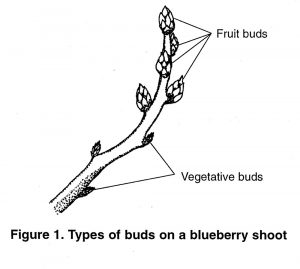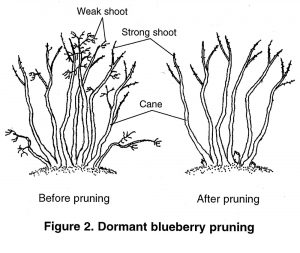Maine Home Garden News — March 2016
- March Is the Month to . . .
- Prune Your Blueberries!
- Staff Favorites — Pussy Willow (Salix discolor)
- Two Years of One Tomato
- Food & Nutrition: Make Mine REAL Maple Syrup!
March Is the Month to . . .
By Amy Witt, Home Horticulturist, UMaine Exyension Cumberland County
- Prune fruit trees and certain woody landscape plants. Typically, shrubs that flower after June should be pruned in the late winter/early spring. When pruning, keep in mind the rudimentary three “Ds”: remove damaged, diseased, and dead branches. For more information, see Pruning Woody Landscape Plants, Growing Fruit Trees in Maine: Pruning, and the Pruning Ornamental Trees video below.
- Examine fruit tree trunks and other woody plants for damage caused by mice or voles, porcupines, and browsing by deer.
- Take care of the tunnels and mounds of dirt created by moles and voles. They should be leveled with a metal rake and packed firmly. The exposed soil can later be reseeded with grass seed.
 Clean out and inspect birdhouses to make sure they’re firmly mounted. Create a pile of ready-for-the-taking nesting materials such as dryer lint, feathers, and yarn to make nest building easier.
Clean out and inspect birdhouses to make sure they’re firmly mounted. Create a pile of ready-for-the-taking nesting materials such as dryer lint, feathers, and yarn to make nest building easier.- Learn when to expect your last frost date.
- Dig compost, manure, and other needed amendments into your garden soil as soon as conditions allow.
- Check out UMaine Extension’s seed starting resources: Starting Seeds at Home and our How to Build a Seedling Stand video below.
- Consider starting a garden journal this year by keeping track of your garden-related activities and items such as planting schedules and charts, vegetable yields, weather records, photos, plant lists, seed packets, pest and disease problems, wildlife sightings, monthly planning lists, etc.
 Don’t forget to clean and sharpen tools; check hoses and drip lines for leaks and repair as necessary; wash empty plant pots with a 10 percent bleach to water solution; scrub your deck/patio and hardscapes around your house and garden; and clean out gutters to prevent water from drowning the plants below.
Don’t forget to clean and sharpen tools; check hoses and drip lines for leaks and repair as necessary; wash empty plant pots with a 10 percent bleach to water solution; scrub your deck/patio and hardscapes around your house and garden; and clean out gutters to prevent water from drowning the plants below.- Clean up perennial beds by removing debris from last season. Cut back perennials almost to ground level. Now is also a good time to dig and divide emerging perennials.
- Add trellises and supports so plants can utilize them as they grow. Adding supports later can be problematic.
-
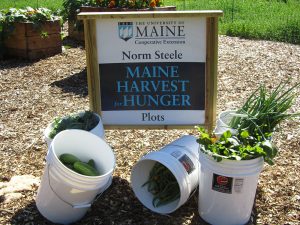
Norm Steele Maine Harvest for Hunger Plots. Photo by Amy Witt. Connect with UMaine Extension’s Maine Harvest for Hunger program. Ways to get involved include growing extra produce and donating it to a local food pantry or a neighbor in need; signing-up with your local UMaine Extension office as a volunteer to help glean produce from local farms and orchards; helping to establish a Maine Harvest for Hunger plot as part of your local community garden.
- Attend your local Maine Maple Sunday event — always the 4th Sunday in March!
Prune Your Blueberries!
By David Handley, Vegetable and Small Fruit Specialist, UMaine Extension
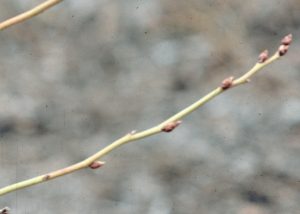
Why? Highbush blueberry bushes should be pruned every year to produce regular crops of good quality fruit. Good pruning opens up the bush to more light and air movement, which will reduce disease problems. It also improves berry flavor and size, and encourages earlier ripening.
When? Prune the plants when they are fully dormant, in late winter or early spring. Here in Monmouth, Maine, we usually prune in March, when the snow has receded enough to allow cutting canes back to the base of the plant.
How? For young bushes less than three years old, just cut out any dead branches and weak, spindly growth.
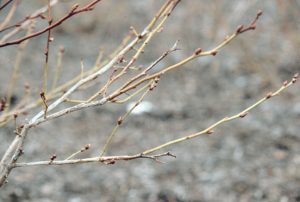
Mature blueberry plants (4 years and older) should have six to ten healthy canes coming up from the base of the plant, ranging in age from one to six years old. The canes will vary in height from 4 to 6 feet, depending on variety. Each year prune the plants as follows:
- Prune out any weak, low-growing or diseased canes.
- Prune out any canes that are more than six years old (these are usually the thickest canes, with gray, peeling bark). Older canes are less productive and should be pruned out in favor of younger, more vigorous canes. The most productive canes on a blueberry bush are three to five years old. Cut the old canes back to ground. Leave six to seven vigorous two- to five-year-old canes and two or three one-year-old canes per bush.
- Now move into the upper part of the plant and trim out any weak branches that have no vigorous new shoot growth on them, especially those in the center of the bush that are likely to be shaded. Then thin out the fruiting shoots on the remaining branches. These are the shoots that grew out last summer and are typically green or reddish in color and vary in length from two to ten inches. They have swollen teardrop-shaped fruit buds near the tip, and smaller, pointed vegetative buds towards the base. Each fruit bud will produce a cluster of about six flowers in the spring. Trim out the shorter, weaker shoots, especially those less than six inches in length.
That’s it! This should leave you with a bush with about ten canes, ranging in age from one to six years old, each with several branches that have strong fruiting shoots on them. Once you get the knack of it, it really shouldn’t take more that about ten minutes to prune a bush; otherwise, you’re thinking too hard.
Note: One of the myths of pruning is that it will increase yield. Quite the opposite is true. If you are doing a good job of pruning a blueberry bush about one-half of the potential crop will be removed. However, the payoff will be in the improved quality of the fruit, reduced disease problems, and more dependable crops.
For more information, see Bulletin #2253, Growing Highbush Blueberries or watch the video below.
Staff Favorites — Pussy Willow (Salix discolor)
By Kate Garland, Horticulturalist, UMaine Extension Penobscot County
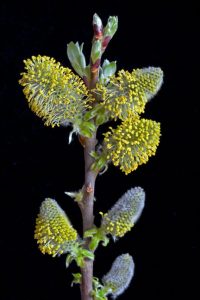
My sweet, innocent mother once attracted the attention of the local police on a sunny day in March years ago, when she was caught traveling down a bumpy, dead-end dirt road in pursuit of her favorite harbinger of spring: pussy willow (Salix discolor). The police officer checking on this shady wanderer was amused at her mission and let her go without trouble, but the story was cemented on our family record. Many Mainers share this deep fondness for pussy willow stems because the silken buds indicate longer days and warmer temperatures are on the way. However, people often are not aware of the fascinating biology that is behind the buds, its importance in pollinator habitat, and the role it can play in managed landscapes.
Biology and pollinator habitat
If you’ve ever placed pussy willow cuttings in water, you know they’ll eventually swell into a yellow or greenish/yellow mass, sometimes leaving large amounts of golden dust behind. This is because water moves into the buds, allowing them to develop into a collection of flowers (inflorescence). What’s especially interesting is that all flowers from a single plant will be the same gender. In other words, there are male pussy willow plants and female pussy willow plants. The botanical term for this is “dioecous,” from the Greek dioecy, meaning “two houses.” Male plants tend to develop larger, showier buds, but either gender plant will have the distinctive fuzziness.
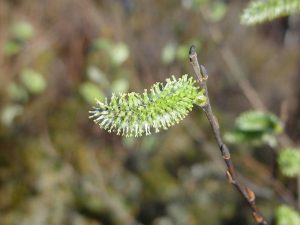
Wind and insects pollinate willow flowers, which are very important sources of nectar and pollen in the early season. Take a moment to observe a willow in bloom on a warm day this spring and you’ll be amazed at the amount of activity and the diversity of insects supported by this species. It’s another excellent example of the natural reciprocal partnership between our native plants and the native insect species they support.
A number of different willow species co-exist in the wild and have a tendency to cross-pollinate promiscuously resulting in hybrid seeds. The best means to propagate willows is by hardwood cuttings taken in early spring. See Plant Propagation in Maine for more details.
Landscape use
As mentioned, Salix discolor is native to Maine. It thrives in medium to wet soils and full sun to part shade, but performs best in full sun and moist soil where it can grow up to 15′ tall and spread about 12′ wide. If this seems too large for your liking, it’s possible to maintain the shrub at a smaller height through annual pruning. Other than that occasional intervention, this is a true low-maintenance plant with very few problems. It makes a great addition to a natural looking mixed hedge or rain garden.
This plant deserves a spot in more home landscapes. We gifted mom her own pussy willow shrub for her birthday a few years ago, now planted in a moist sunny swale along their property line. Hopefully she won’t find herself “in trouble” with the law again.
 Two Years of One Tomato
Two Years of One Tomato
By Donna Coffin, Extension Educator, UMaine Extension Piscataquis County
If you haven’t grown a garden ever or it has been a long time since you had a garden, planting a garden seems intimidating and overwhelming to some folks. To try to encourage more people to grow their own vegetables, UMaine Extension Piscataquis County Executive Committee funded the One Tomato project.
 In the past two years, one cherry tomato plant was given to 495 folks at food cupboards, a community event, and at the UMaine Extension office, to plant in a container or in a garden to take care of and harvest during the growing season. Participants were given fact sheets on container gardening and could sign up for a newsletter or view Facebook postings. Seventy-five plants were given to a prison garden that provides food for the food cupboards.
In the past two years, one cherry tomato plant was given to 495 folks at food cupboards, a community event, and at the UMaine Extension office, to plant in a container or in a garden to take care of and harvest during the growing season. Participants were given fact sheets on container gardening and could sign up for a newsletter or view Facebook postings. Seventy-five plants were given to a prison garden that provides food for the food cupboards.
Of the 495 people who completed the survey, 78 (16%) had never gardened and this was their first garden, 90 (18%) have only gardened 1 to 3 years. 167 (46%) signed up for the electronic newsletter. For 25% of the people, this was the first contact they had with UMaine Extension.
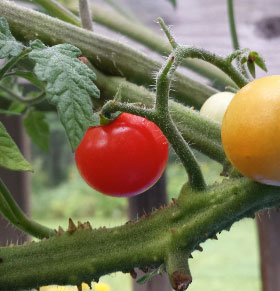 A mid-season (38 gardeners) and end-of-season (39 gardeners) oral interview was done to assess the progress of the plants. 23% of gardeners were male and 77% female. Plant health was rated at good (81%), bad (14%) or the plant died (5%). At the end of the season, 19% had no harvest, 38% harvested a handful of cherry tomatoes, 19% harvested a bowl full, and 25% said they harvested a bucket full of tomatoes. If the handful (cup) was valued at $1, the bowl full (pint) at $5, and the bucket full (gallon) at $20 then the estimated value of harvest of all plants distributed was over $3,100.
A mid-season (38 gardeners) and end-of-season (39 gardeners) oral interview was done to assess the progress of the plants. 23% of gardeners were male and 77% female. Plant health was rated at good (81%), bad (14%) or the plant died (5%). At the end of the season, 19% had no harvest, 38% harvested a handful of cherry tomatoes, 19% harvested a bowl full, and 25% said they harvested a bucket full of tomatoes. If the handful (cup) was valued at $1, the bowl full (pint) at $5, and the bucket full (gallon) at $20 then the estimated value of harvest of all plants distributed was over $3,100.
 Food & Nutrition:
Food & Nutrition:
Make Mine REAL Maple Syrup!
By Kathy Savoie, MS, RD, Associate Extension Professor, UMaine Extension
There is no better way to celebrate the arrival of spring than to enjoy the true New England flavor of real maple syrup. Having grown up in Vermont, I have a true affinity for real maple syrup and cannot be fooled by substitutes. The arrival of maple cream, maple sugar candy or maple syrup is cause for a moment of silence in my home. It is a burst of nature’s wonder in my mouth that satisfies my soul.
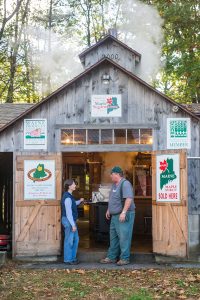 The bounty of maple-based products goes far beyond the traditional maple syrup on pancakes. Have you tried maple coated nuts, maple cream, maple butter, maple taffy, maple cotton candy, or maple sugar candy? Take an opportunity to explore the world of maple products and a sugar house on Maine Maple Sunday, celebrated across the state on March 27, 2016.
The bounty of maple-based products goes far beyond the traditional maple syrup on pancakes. Have you tried maple coated nuts, maple cream, maple butter, maple taffy, maple cotton candy, or maple sugar candy? Take an opportunity to explore the world of maple products and a sugar house on Maine Maple Sunday, celebrated across the state on March 27, 2016.
Most people associate maple syrup with pancakes. Consider using the following Rolled Oats Convenience Mix to make your next batch of pancakes. Rolled oats are a source of whole grains and provide a boost of fiber beyond typical pancake recipes. Preparing and using your own homemade convenience mix is a way for busy folks to be prepared in advance for those early morning pancake breakfasts requests while saving money and having greater control over the nutritional value of foods for their family.
Rolled Oats Convenience Mix
2 cups flour
2 cups whole wheat flour
4 cups quick-cooking oats (not instant)
1 ½ cups nonfat dry milk
¼ cup baking powder
2/3 cup canola oil
Put all ingredients except oil in large bowl and stir until very well mixed. Pour in oil and with a fork or pastry blender stir until well blended. Cover and refrigerate; will keep 1 month.
NOTE: Store in airtight glass jars or canisters. To measure, spoon into cup, pack lightly and level off. Makes 10 cups
Oat Pancakes
1 ½ cups Rolled Oats Convenience Mix
1 cup water
1 egg
Stir all ingredients in a bowl with a spoon until blended. Cook on hot griddle or skillet until brown on both sides. Makes about 16, three-inch pancakes.
If you are wondering how much maple syrup you should use in place of white sugar, it depends on whether that recipe is for baking or general cooking.
In baking, replace 1 cup of white sugar with 3/4 cup of maple syrup and reduce by 3 tablespoons the other liquid content in the recipe for every cup of maple syrup used. Because maple syrup is brown and granulated sugar is white, this replacement will darken your baked goods and cause them to brown quicker.
To substitute maple syrup for sugar in other types of cooking, use three quarters of maple syrup as the sugar called for.
Keep in mind that maple syrup is not as sweet as white sugar and therefore this substitution formula will likely yield a less sweet result than the original recipe.
For more information and recipes on how to use convenience mixes as well as how to tap your own maple trees and make maple syrup, check out the University of Maine Cooperative Extension at extension.umaine.edu
University of Maine Cooperative Extension’s Maine Home Garden News is designed to equip home gardeners with practical, timely information.
Let us know if you would like to be notified when new issues are posted. To receive e-mail notifications fill out our online form.
For more information or questions, contact Lynne Hazelton at lynne.b.hazelton@maine.edu or 1.800.287.1471 (in Maine).
Visit our Archives to see past issues.
Maine Home Garden News was created in response to a continued increase in requests for information on gardening and includes timely and seasonal tips, as well as research-based articles on all aspects of gardening. Articles are written by UMaine Extension specialists, educators, and horticulture professionals, as well as Master Gardener Volunteers from around Maine, with Katherine Garland, UMaine Extension Horticulturalist in Penobscot County, serving as editor.
Information in this publication is provided purely for educational purposes. No responsibility is assumed for any problems associated with the use of products or services mentioned. No endorsement of products or companies is intended, nor is criticism of unnamed products or companies implied.
© 2016
Call 800.287.0274 (in Maine), or 207.581.3188, for information on publications and program offerings from University of Maine Cooperative Extension, or visit extension.umaine.edu.

